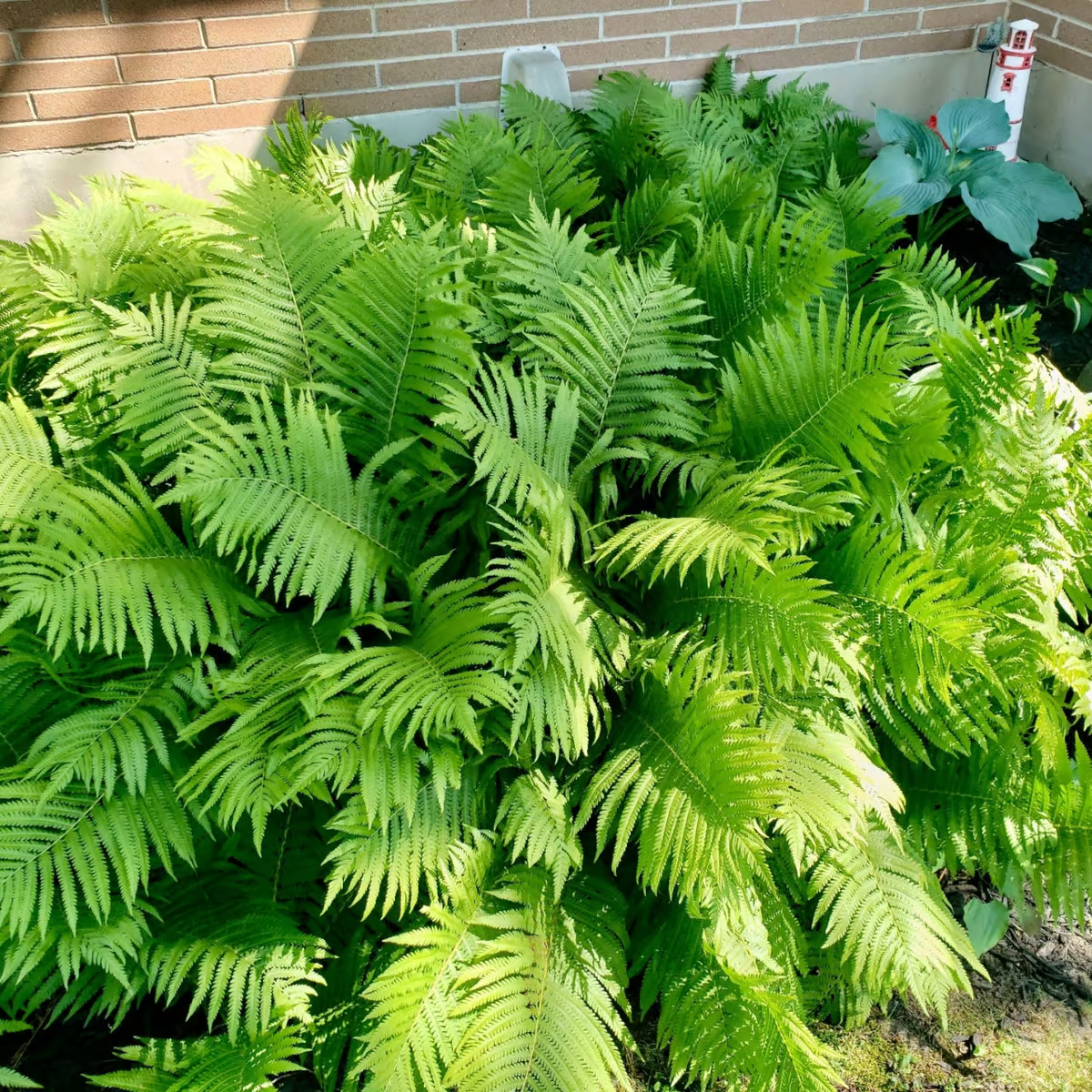
Perennials
Low-maintenance, hardy garden addition
Effective at soil erosion control
Great for naturalistic garden designs
Thrives in
ZONE 3ZONE 4ZONE 5ZONE 6ZONE 7Planting Season:
Year-RoundWhen you add one plant to cart, it automatically adds the second one free on Bogo deals.
Ostrich Ferns are attractive and dimorphic plants that gardeners use all year round to beautify their patches in shaded areas. In its nonfertile state, the plant grows to a height of 6 feet, and its gorgeous fronds resemble ostrich plumes, hence the plant's name.
The fern is much smaller in its dormant state, which occurs in the fall and early winter. However, The shape is interesting, so it still provides pleasing shapes in a garden, even if that shape changes.
When nonfertile, the fern is a rich, almost Kelly green, with arching fronds swooshing enticingly in the breeze. It contrasts with other blooming plants and serves as a color anchor in a garden of flowers.
They're hardy, too, so you can plant them nearly anywhere to beautify a particular place. Although they aren't green and sweeping in the winter, they're still attractive as they survive the cold and snow while the perennials snooze until spring.
First, the fern's extensive root system is a great soil stabilizer, and the other plants in the garden will benefit because the fern's roots prevent erosion and nutrient loss in the soil. Second, they are a boon to various garden-dwelling wildlife.
The Serenity of Ostrich Fern Practitioners of feng shui relies on the fern to bring harmony to a dwelling and the adjacent garden. The way it morphs back into a verdant, thriving plant after being so much smaller throughout the winter also symbolizes new beginnings.

Height at Maturity
Over 2 Feet
Care
Ostrich ferns thrive in moist, well-drained soil. Water regularly to keep the soil always damp but not soggy. Apply a layer of mulch to maintain dampness and suppress weeds. Prune back any dead or damaged fronds in early spring.
Plant Reproduction
Ostrich Fern spreads by creeping rhizomes and forming dense clumps
Choose early spring or fall when the soil is moist and cool to plant healthy bare-root ferns. You can also use dormant plants to grow year-round. When you arrive, please soak the roots in water for several hours to rehydrate them. Ferns thrive in moist and shaded areas. Dig a hole wide and deep enough to spread out the roots comfortably. Position the fern so the crown (where the roots meet the fronds) is just at or slightly below ground level. Gently backfill with soil firmly around the roots, and thoroughly water to settle the soil and eliminate air pockets. Apply a 2-3 inch layer of mulch for weed control and to retain moisture, ensuring the mulch does not touch the crown. Water during dry periods is used to keep soil moist but not soggy. Avoid fertilizing in the first year, as ferns prefer nutrient-rich soil over direct fertilization.
Shipping date depends on the date displayed and chosen when you order from the product's page.
We only accept returns on plants verified dead. If you think your plants have died, we offer a 1 year warranty, please use use this File a Claim Link to verify dead plants and start with return warranty process.






Lush Appearance:
Their dense, feather-like foliage creates a full, rich look in your landscape.
Flexible Planting:
Ideal for borders, containers, or ground cover, these ferns enhance any garden setting.
Easy Care:
Minimal maintenance makes Ostrich Ferns a great choice for a fuss-free garden.
Shade Friendly:
Perfect for low-light areas, these ferns brighten up shady spots effortlessly.
Caring Tips
Each box contains detailed care instructions and information about your product. But here's the basics.
Care Tips
Ostrich ferns thrive in moist, well-drained soil. Water regularly to keep the soil always damp but not soggy. Apply a layer of mulch to maintain dampness and suppress weeds. Prune back any dead or damaged fronds in early spring.
Light Requirements
Ostrich Fern (Matteuccia struthiopteris) thrives in partial to full shade, making it perfect for woods gardens or shaded areas. It prefers filtered sunlight or dappled light, which helps maintain its lush, green foliage and prevents leaf scorch.
Hardy Planting Zones
3 • 4 • 5 • 6 • 7
How often should I water my plants?
How do I know if my plant is getting too much or too little sunlight?
What should I do to prepare my plants for winter?
What are the signs that my plant needs fertilizing?
How can I prevent pests from damaging my plants?
How do I choose the right plant for my climate zone?